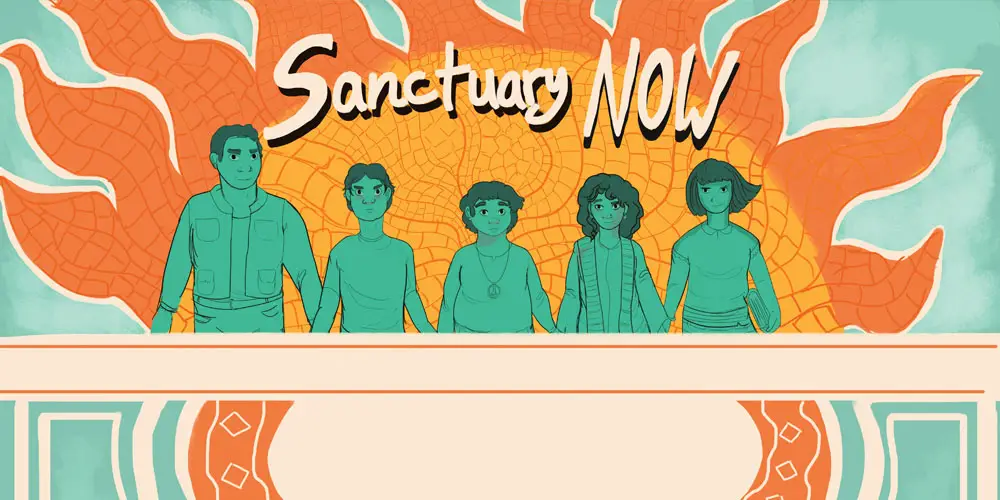When President Donald Trump was elected to office in November 2016, an enormous, passionate outcry from many American students ensued. College students throughout the country gathered together and put on impassioned displays of political and social activism, from demonstrations about open-carry policies to protests against racial discrimination. Immigrant students wept in fear for their families, and those who participate in DACA (Deferred Action for Childhood Arrivals) anxiously waited to find out if they’d be allowed to continue their studies in this country.
Suddenly, a new buzzword began flying around campuses throughout America: “sanctuary.” Students of all race, gender and ethnicity want to feel protected, not only by their government, but also by the schools they attend. As colleges and universities became places of increasing division and political discourse, various student-led groups began to establish their place in the chaos, and student safety is now on the top of their agenda.
At the University of North Texas and Texas Women’s University, one of these recently-created groups has stirred up controversial conversations in its call for immigrant student protection. Students from both universities have come together in the name of a common cause, despite residing on different campuses.
The group, dubbed “The Sanctuary Taskforce,” is led by students who ask that the rights of undocumented and immigrant students, as well as minority individuals, be defended by their universities. More specifically, UNT and TWU students are battling to label their campuses as “sanctuary campuses.”
As David Lopez, a UNT senior and president of the Chicano/Latino group “Mueve,” explains, “On a sanctuary campus, the administration prevents ICE (Immigration and Customs Enforcement) and border control from entering school grounds to deport undocumented students. The main purpose is to protect undocumented students, especially those involved in DACA.”

Although American schools would not legally be able to withstand the investigation or deportation of a student if pressured to comply by the government, sanctuary campuses would extend as much protection as possible to immigrant students’ security and comfort. Undocumented students would be treated with as much respect as any other student, and legal resources, counseling services and housing assistance would be provided to those in need.
“With the help of others in the group, I co-wrote and edited a petition to be submitted to the school,” Taskforce member Lopez says. “Undocumented students would feel much safer if UNT became a sanctuary campus, and we need to know that our university cares about its most marginalized students.”
Sanctuary Taskforce member and recent UNT graduate Stephanie Plancarte has a personal connection to the movement that fuels her participation in the group. After obtaining her degree in International Studies with a concentration in Peace Studies, she partnered with David Lopez in the creation of the petition.
“I just graduated and I have dual citizenship,” Plancarte said. “The reason I just stated these two facts is because they make up my privilege. If there is something going on which you yourself are not affected by, then you are privileged to not have to struggle because of it. It is because of my privilege I stand up for my close friends who have DACA, my family members who are undocumented and my classmates.”
Plancarte sees no reason for UNT not to become a sanctuary campus. “UNT is an institution that prides itself on diversity,” she says. “Therefore, backing a movement like this would only help the institution. If undocumented students do not feel comfortable at UNT, they can in fact choose to transfer to a different school, perhaps one that does care about their needs. [As a result], UNT would lose a lot of money, so if the petition is accepted, it is a win-win.”
UNT and TWU are not the only Texas schools with students who advocate for sanctuary campuses. The University of Texas at Austin, Texas State University, University of El Paso, UTD and the University of Houston, as well as others, have students who have made similar demands of their administrations. “The idea for our petition was inspired by other schools participating in the sanctuary movement,” Lopez admits. “We looked at schools like the University of Houston and took the steps we needed to.”
Lopez and other members of the Sanctuary Taskforce know that the establishment of a sanctuary campus is possible. By November 2016, more than 25 universities in California were offering sanctuary, and dozens of universities across the country are requesting similar accommodations for the undocumented students. However, not every state is so eager to welcome the controversial idea
The concept of sanctuary campuses pushes the boundaries between education and government, and, as a result, has been met with extreme debate, especially in the conservative state of Texas. When calls for sanctuary campuses began to reach the ears of legislatures after President Trump’s election, Texas Governor Greg Abbott vowed in a tweet on December 1 to halt funding for any state university that deemed itself a sanctuary campus. Heated discussions about the legality and necessity of sanctuary campuses broke out on the news, in classrooms, and perhaps most importantly, amongst administrators and legislators.
Rachel Herrera, a sophomore at TWU studying Child Development and another member of the Sanctuary Taskforce, refuses to believe that warnings like Abbott’s will prevent the implementation of safety protocols for undocumented students.
“State funds are important, but students need to be represented and protected,” she says. “If Abbott really wants to veto funding, he would have to do so with the agreement of the House and the Senate, which I doubt will happen. We aren’t going to give up from this simple threat. We will keep fighting for what we demand and deserve.”
Like Plancarte, Herrera feels personally affected by the discussion of immigration. “I have friends at UNT and TWU that are students under DACA and would be terrified if their safety was in danger,” she says. “I also have friends that are of different minority statuses that need to be represented. I, myself, am a disabled Hispanic female and feel threated by the recent election.”
The Sanctuary Taskforce has attempted to raise awareness about the petition on TWU and UNT campuses via various methods. “A lot of people did not know what the sanctuary movement was until we had our first rally,” Lopez says. “Thanks to rallies, social media and us getting the word out, a lot more people have become interested in not just signing the petition, but also in joining Latin organizations and becoming more politically active.”
Despite the Taskforce’s fervent attempts to push the petition, the members are under the impression that many administrators are reluctant to hear their pleas. “UNT’s president has been very unwilling and unhelpful in the process of meeting our demands,” Lopez says. “Even if he doesn’t use the word ‘sanctuary,’ we want him to guarantee that there will be no cooperation with ICE or border control and that our undocumented students will be protected on campus.”
Herrera has hope that the administrators at TWU will respond more positively to the petition for a sanctuary campus.
“We have always been a campus for the underrepresented, and I’m ready for us to represent this group of students, as well,” she says. “I would be amazed to be supported by my college campus. To hear that the administration supports me and all other marginalized students on campus would be very powerful.”
Regardless of the reluctance on the part of administrators, the Taskforce has witnessed a surge in student support. They also believe that the movement has brought the campuses together in the wake of the presidential election. “At every rally or protest we’ve hosted on both campuses, there have been huge turnouts for only a day or two each of advertising and promoting,” Herrera says. “This gives us hope that we are not alone in our thoughts, and that we are united as a student body. Despite the few people that decide to speak against our movement, we are pleased to have unified ideals across campuses.”
Despite the evidence of strong student support, civilian and legislative backing has been slow to obtain. Many wonder how such a blatant lack of cooperation of schools with the law is legal. Lopez argues that the process would be legal, saying “University campuses are paid for by students, and although some are considered public property, the administration has the power to not allow police or border control on campus if they choose to do so.” He believes that Governor Abbott’s tweet about sanctuary schools actually supports the idea that they could legitimately exist. If they weren’t a viable and legal option, why would the government even address the issue?

Herrera shakes her head at those who oppose the idea of sanctuary campuses. “They are uneducated,” she says. “They do not know how difficult it is to gain citizenship in America. They do not know the amazing and dedicated students they would be helping. They just don’t know what a sanctuary campus would do to help all students.”
While Herrera and the other Sanctuary Taskforce members have continued to fight for attention and legitimacy, as well as for their recently submitted petition, Texas legislators have been preparing to deal with the controversial issue. Most seem to be working against the implementation of sanctuary campuses, expressing concerns about the issue’s legality and the effects it would have on relations with police and border control.
On February 1, Governor Abbott publically referenced sanctuary campuses for the second time in his state of the state address, saying that the issue would be fast-tracked through the legislature. “If Governor Abott really does cut funding for any schools that become sanctuary campuses, it would be an economic disaster,” says Lopez. He doesn’t believe it will happen, and most members of the Taskforce agree with him.
Plancarte bristles at the governor’s lack of support. “He needs to stop choosing money and self-interest over future Texan education,” she says. She believes the conservative nature of Texas, and its legislators, has made the process of establishing sanctuary campuses more difficult.
Although Texas schools are struggling more than some to become sanctuary campuses, other colleges across the nation have also failed in their mission. Arkansas, Georgia and other states express similar concerns to those voiced in Texas. The big question still remains, despite endless debates: Can sanctuary campuses legally extend protection to students, no matter what the government says about undocumented immigrants or DACA participants?
“I’m glad that some campuses have become sanctuaries and that some administrations have really listened to their students,” Lopez says. “If some administrations won’t do so, it’s for selfish reasons, not because they are truly interested in students’ well-being.”
Herrera also argues that some administrators are fighting against sanctuary campuses for the wrong reasons. “They are only concerned with the documentation status of whoever is being helped, which is an immature view,” she says. “Undocumented students are students too, and deserve to be treated like so.”
The Taskforce has not been shaken by Governor Abbott’s statements or the general hesitancy expressed by the public. “Whether the president of UNT and others are willing or not, there is a willingness in us to keep moving forward with this proposal,” Lopez says. “Our Sanctuary Taskforce is still meeting, and we will continue to discuss further steps. Even if our school isn’t deemed a sanctuary school, we want to know that our marginalized students will be protected. It’s an issue of life for them.”
Over the next few months, the issue of sanctuary campuses will continue to attract attention from civilians, students, administrators and government officials. Although the future of such campuses seems hazy, students like Lopez, Herrera and Plancarte plan to continuously fight for the rights of immigrant students however they can. They take the matter seriously, and in their opinion, so should everyone else.

















